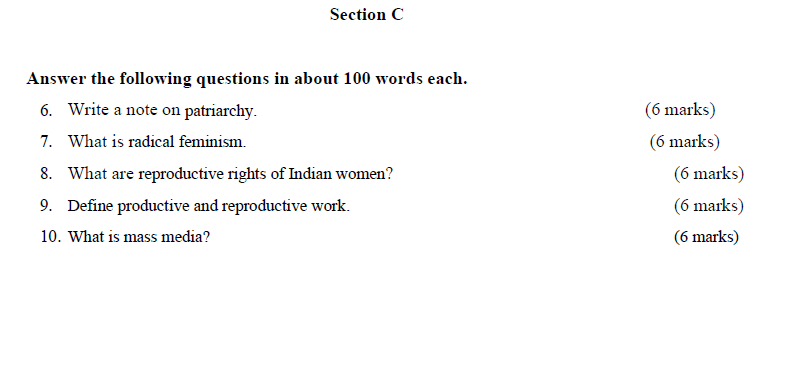BGDG 172 IGNOU Solved Assignment 2023 (Free)

BGDG 172 IGNOU Solved Assignment 2023 (Free)
Looking for BGDG 172 IGNOU Solved Assignment 2023 (Free) ? Look no further! Our website offers high-quality, comprehensive solutions to all your IGNOU assignment needs. With a team of experienced tutors and a commitment to excellence, we provide reliable and affordable assistance to students across India. Get started today and take your studies to the next level with our expert help.
BGDG 172 Assignment Important Details 2023
| Programme code | BAG |
|---|---|
| Assignment Code | BGDG 172 |
| Subject Title | Gender Sensitization : Society and Culture |
| Last date to submit assignment (extended) | 15 May 2023 |
| Eligibility | July 2022- June 2023 session students and January 2023 session students |
| Official Last date to submit | 30 April 2023 (over) |
| Total Marks | 100 Marks |
| Number of Parts to complete | 3 parts (Section A, Section B and Section C) |
| Number of questions | 10 |
Questions and Answers (Solved)
Section A
Q.1 Describe the terms masculinity and femininity in India? Do you think it shapes gender roles? Explain. (500 words)
Ans. The concepts of masculinity and femininity in India are deeply rooted in cultural and social norms. While India is a diverse country with many different cultural practices, certain patterns emerge when it comes to the construction of gender roles.
Masculinity in India is often associated with strength, bravery, and dominance. Men are expected to be the primary breadwinners and protectors of their families.
There is often a strong emphasis on physical strength and virility, with men being encouraged to engage in physical activities such as sports and exercise. Men are also expected to be assertive and competitive, especially in the workplace.
Femininity, on the other hand, is associated with nurturing, caregiving, and domesticity. Women are expected to prioritize their roles as wives and mothers, often at the expense of their own career aspirations.
There is also a strong emphasis on modesty and chastity, with women being expected to dress and behave in ways that are considered appropriate for their gender. Women are often discouraged from participating in physically demanding activities or pursuing careers that are seen as traditionally masculine.
These gender roles are deeply ingrained in Indian society and are reinforced by various institutions such as the family, religion, and the media. For example, many Indian families place a high value on arranged marriages, which reinforce traditional gender roles and expectations.
Women are often expected to prioritize their roles as wives and mothers over their own personal aspirations, while men are expected to provide for their families and be the primary decision-makers.
The media also plays a significant role in shaping gender roles in India. Popular culture often reinforces traditional gender roles, portraying women as submissive and passive while men are depicted as strong and dominant.
Women are often sexualized in the media, which reinforces the idea that their primary value lies in their physical appearance and their ability to attract men.
These traditional gender roles can have negative consequences for both men and women. Men who are unable to meet societal expectations of masculinity may experience feelings of inadequacy and shame.
Women who are unable to conform to traditional gender roles may face discrimination and exclusion from various aspects of society.
However, there are also many individuals and organizations working to challenge traditional gender roles in India. For example, there are increasing numbers of women entering the workforce and pursuing careers traditionally seen as masculine.
There are also campaigns to promote gender equality and challenge harmful stereotypes in the media.
In conclusion, the concepts of masculinity and femininity in India are deeply ingrained in cultural and social norms. While these gender roles can have negative consequences, there are also many individuals and organizations working to challenge traditional norms and promote gender equality.
Check BGDG 172 IGNOU solved assignment 2023-24 (Free)

Q.2 Describe the relationship of labour force participation, economy and gender question as a key focus. Support your argument by providing suitable examples. (500 words)
Ans. The relationship between labour force participation, economy, and gender is a complex and multifaceted one. Historically, women have been excluded from the formal labour force in many countries, including developing countries like India, where cultural norms and social expectations have often placed women in the role of caregivers and homemakers.
However, this has changed over time, as women have increasingly entered the workforce in many countries.
In many developed countries, the labour force participation rate for women has been steadily increasing over the past few decades. This has been driven by a number of factors, including changes in social attitudes towards women’s roles, increased access to education and training, and the need for dual-income households.
For example, in the United States, the labour force participation rate for women has increased from around 43% in 1970 to over 57% in 2019 (World Bank, 2021). This increase in women’s labour force participation has had a significant impact on the economy, as it has led to increased productivity, higher levels of household income, and greater gender equality in the workforce.
However, there are still significant gender disparities in labour force participation rates in many developed countries. For example, in Japan, the labour force participation rate for women is only around 52%, compared to around 77% for men (World Bank, 2021).
This is due in part to cultural attitudes towards women’s roles, as well as a lack of policies and infrastructure to support working mothers, such as affordable childcare and flexible work arrangements.
Check IGNOU assignment submission status
In many developing countries, women’s labour force participation rates are also increasing, although they still tend to be lower than men’s. In India, for example, the labour force participation rate for women is around 22%, compared to around 75% for men (World Bank, 2021).
This is due in part to cultural expectations that women should prioritize their roles as caregivers and homemakers, as well as a lack of opportunities for women in certain sectors of the economy.
However, there are also examples of developing countries where women’s labour force participation rates are higher than men’s. For example, in Rwanda, the labour force participation rate for women is around 85%, compared to around 70% for men (World Bank, 2021).
This is due in part to policies and programs aimed at promoting gender equality, such as quotas for women in political office and entrepreneurship programs for women.
The relationship between labour force participation, economy, and gender is a complex one, and there are many factors that can influence it. However, it is clear that increasing women’s labour force participation rates can have significant positive impacts on the economy, including increased productivity, higher levels of household income, and greater gender equality in the workforce.
To achieve this, it is important to address the cultural and social barriers that can prevent women from participating in the labour force, as well as to implement policies and programs that support working mothers and promote gender equality in the workforce.
In conclusion, labour force participation, economy, and gender are deeply interconnected, and increasing women’s labour force participation rates can have significant positive impacts on the economy.
However, there are still significant gender disparities in labour force participation rates in many countries, and it is important to address these disparities in order to achieve greater gender equality in the workforce and promote economic growth.

Section B
Q.3 Critically evaluate the role of the family from gender lens. (250 words)
Ans. The family plays a crucial role in shaping gender roles and identities. Traditionally, the family has been seen as a place where gender norms are reinforced and transmitted from one generation to the next.
In many cultures, boys and girls are socialized differently from a young age, with boys being encouraged to be more independent and assertive, while girls are encouraged to be more nurturing and supportive.
This can lead to the reinforcement of traditional gender roles and the perpetuation of gender inequality.However, the family can also be a site of resistance to gender norms and can play a positive role in challenging gender inequality.
For example, families can encourage their children to explore a wide range of interests and hobbies, regardless of their gender, and can provide them with role models of both genders who challenge traditional gender norms.
At the same time, the family can also perpetuate gender inequality through the division of labor within the household. Women are often responsible for the majority of unpaid care work, such as cooking, cleaning, and childcare, which can limit their opportunities to participate in the paid labor force and can perpetuate gender inequality in the workplace.
Men are often socialized to be the primary breadwinners, which can place pressure on them to prioritize their careers over their family responsibilities.
Overall, the family plays a complex role in shaping gender roles and identities. While it can reinforce traditional gender norms and perpetuate gender inequality, it can also challenge gender norms and provide opportunities for resistance and change.
It is important to recognize the ways in which the family can perpetuate gender inequality and to work towards creating more equitable family structures that promote gender equality.
Q.4 What is Sexual Harassment at Workplace. Examine its forms. (250 words)
Ans. Sexual harassment at the workplace is a form of discrimination based on gender and is considered a violation of human rights. It is defined as any unwelcome sexual advance, request for sexual favors or other verbal or physical conduct of a sexual nature that creates a hostile or intimidating work environment. Sexual harassment can occur between co-workers or between an employee and a supervisor.
Forms of sexual harassment at the workplace can include:
Physical harassment: This includes physical touching, assault or molestation, and can be any unwelcome physical contact of a sexual nature.
Verbal harassment: This includes comments or jokes of a sexual nature, unwanted sexual advances, and any other comments that are intended to be sexually suggestive or demeaning.
Visual harassment: This includes displaying sexually suggestive or explicit materials, such as posters or images, in the workplace.
Psychological harassment: This includes any behavior that creates a hostile or intimidating work environment, such as making unwanted sexual advances or comments, or engaging in other behavior that is intended to make an employee feel uncomfortable or unsafe.
Cyber harassment: This includes any form of sexual harassment that takes place through electronic communication, such as email, social media, or instant messaging.
All forms of sexual harassment at the workplace are illegal and can have serious consequences for both the perpetrator and the victim. It is important for employers to take proactive steps to prevent sexual harassment in the workplace and to create a safe and respectful work environment for all employees.
This can include establishing clear policies and procedures for reporting sexual harassment, providing training and education for employees and supervisors, and taking swift and appropriate action to address any instances of sexual harassment that do occur.
Q.5 Write in your own words the ‘construction of a girl child’ with suitable examples. (250 words)
Ans. The construction of a girl child refers to the social and cultural processes through which gender identities are created and reinforced. In many societies, girls are socialized to conform to a specific set of gender norms and expectations, which can limit their opportunities and perpetuate gender inequality.
One example of the construction of a girl child is the way in which girls are often taught to prioritize their appearance over other aspects of their identity. This can be seen in the way that toys and media marketed towards girls often emphasize beauty and fashion, while toys and media marketed towards boys often emphasize adventure and exploration.
This can have a significant impact on the way that girls see themselves and their place in the world, and can limit their opportunities for personal and professional growth.
Another example of the construction of a girl child is the way in which girls are often expected to be more nurturing and supportive than boys. This can be seen in the way that girls are often encouraged to play with dolls and other toys that emphasize caregiving, while boys are encouraged to play with toys that emphasize physical activity and exploration.
This can have a significant impact on the way that girls see themselves and their role in society, and can limit their opportunities for leadership and decision-making.
Overall, the construction of a girl child is a complex and multifaceted process that is shaped by a variety of social and cultural factors. It is important to recognize the ways in which gender norms and expectations can limit the opportunities and potential of girls, and to work towards creating a more equitable and inclusive society that values and supports the diverse identities and experiences of all individuals.

Section C
Q.6 Write a note on patriarchy. (100 words)
Ans. Patriarchy refers to a social system in which men hold primary power and authority, and women are subordinate to men. It is a form of social organization that is characterized by gender inequality, and is often reinforced through cultural norms and practices.
Patriarchy can take many different forms, ranging from overt discrimination and violence against women, to more subtle forms of sexism and gender bias. It is a pervasive and persistent social problem that affects individuals and societies around the world, and requires ongoing efforts to dismantle and replace with more equitable and just social structures.
Q.7 What is radical feminism. (100 words)
Ans. Radical feminism is a form of feminist theory that views gender inequality as a fundamental aspect of social, political, and economic structures.
Radical feminists advocate for the complete restructuring of society in order to eliminate gender-based oppression and discrimination, often focusing on the ways in which patriarchal systems reinforce gender hierarchies and restrict the autonomy and agency of women.
Radical feminism is characterized by its critique of traditional gender roles and norms, and its emphasis on intersectionality and the ways in which gender intersects with other forms of oppression, such as race, class, and sexuality.
Q.8 What are reproductive rights of Indian women? (100 words)
Ans. Reproductive rights of Indian women include the right to access information, services, and resources related to reproductive health, including family planning, safe and legal abortion, and maternal health care.
Indian women also have the right to make decisions about their own bodies and reproductive health, without coercion or discrimination.
The government of India has enacted several policies and programs aimed at promoting reproductive health and rights, including the National Population Policy, which seeks to ensure that all couples have access to family planning and reproductive health services. However, challenges remain in ensuring that all women are able to exercise their reproductive rights, particularly in rural and marginalized communities.
Q.9 Define productive and reproductive work. (100 words)
Ans. Productive work refers to any activity that generates income or contributes to the production of goods and services, such as paid employment, entrepreneurship, or agricultural labor.
Reproductive work, on the other hand, refers to the unpaid labor that is necessary to sustain households and communities, such as child care, elder care, domestic work, and other forms of care work.
Reproductive work is often performed by women and girls, and is undervalued and invisible in many societies. This division of labor reinforces gender inequalities and limits women’s opportunities for economic and social mobility.
Q.10 What is mass media? (100 words)
Ans. Mass media refers to the various forms of communication that are designed to reach large audiences, including print media (such as newspapers and magazines), broadcast media (such as radio and television), and digital media (such as the internet and social media).
Mass media plays an important role in shaping public opinion, disseminating information, and influencing cultural norms and values.
It is a powerful tool for communication and can be used to promote social change and activism, as well as perpetuate stereotypes and reinforce existing power structures.
Also see this : BPCC-131 INGOU Solved Assignment 2023 free
If you like this solved assignment then you will really motivate us by giving us star rating and tell us in the comment which assignment you want, we will upload it As soon as possible…Thank you !!!







